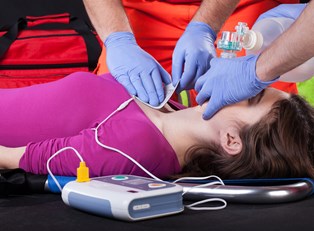An implantable cardioverter defibrillator (ICD) is a medical device that monitors your heartbeat and delivers life-saving electrical shocks when it senses potentially fatal heart rhythm irregularities, also known as arrhythmias. An implantable cardioverter defibrillator can save your life in the event that your heart suddenly stops beating or gets stuck in a dangerous arrhythmia cycle. But what do all of these medical terms mean exactly?
Implantable
ICDs are implanted, which means that they are surgically placed beneath the skin either just under your collar bone or in the abdominal region not far from your heart. The ICD device consists of a battery, a pulse generator, and a small computer. It is thin and almost the size of a pad of regular Post-It notes. The number of wires, also called leads, will vary depending on your condition and the ICD model. One end of a lead plugs into the ICD and the other end has small electrodes that attach to your heart. The electrodes read the speed, strength, and timing of your heart’s muscular chambers. The feedback is sent to the device. The ICD is capable of monitoring and recording your heart rhythms as well as diagnostically responding accordingly.
Implantable cardioverter defibrillators are similar to pacemakers, which are implantable devices that monitor your heart’s rhythms and deliver low-energy pulses to stimulate it to beat more quickly or more strongly. But in addition to the low-pulse currents administered by pacemakers, ICDs can also deliver high-energy shocks. Your physician can program your ICD to suit your specific cardiac needs and can make adjustments if necessary. The battery component of the ICD will usually last five to seven years.
Cardioverter
Cardioversion is the process of converting arrhythmias back to an organized, normal rhythm. There are two ways to accomplish cardioversion as a treatment for arrhythmias: pharmacological cardioversion via medication, and electrical cardioversion via electrical shock impulses to the heart. Your physician may use both means to prevent sudden cardiac arrest (SCA).
SCA occurs when your heart stops beating due to an electrical abnormality. If your heart stops beating, defibrillation must occur within minutes of arrest or sudden cardiac death (SCD) will result.
Defibrillator
Ventricular fibrillation is the most common cause of sudden cardiac arrest. In this case, the lower chambers of the heart, the ventricles, fibrillate or quiver rapidly but do not pump blood. Defibrillation is the process of giving the heart high-energy shocks through an electronic device. Defibrillation can be painful for the patient, but more importantly, it can be life-saving. The Sudden Cardiac Arrest Coalition (SCAC) states that implantable cardioverter defibrillators are 98% effective at protecting those at risk for SCA.
A cardiac electrophysiologist is the kind of physician who typically performs this two- to three-hour surgery. He or she will also program the ICD during surgery and monitor your progress during follow-up appointments. A cardiac electrophysiologist is a doctor who specializes not only in the heart and diseases affecting it, but moreover has additional expertise in the electrical activities of the heart.
Most patients usually stay in the hospital for one day following the surgery. During recovery, activities are usually restricted for a period of about four to six weeks, at which point most patients are granted clearance to resume regular activities.



